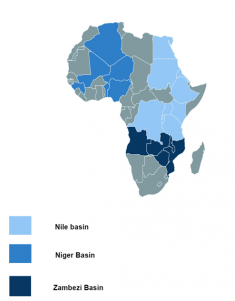Water Insecurity & Climate Change In Africa
Africa has the largest number of surface water bodies crossing or forming international boundaries in the world.
The ten largest water surfaces in Africa span 34 countries and have a total drainage area of 350,000 km2.
However institutional incapacity and inadequate financial resources increase the difficulty of managing shared water resources, as does the fact that a large number of countries share multiple river and lake basins. This state of affairs raises concerns, as inadequate management makes it hard for basin countries to adopt necessary mitigation and adaptation strategies. Water insecurity could have huge economic and political implications across the region.
Climate Change Effects on Water Security in Africa
In Africa, climate change will impact surface water resources through changes in hydrological cycles, the balance of temperature, and rainfall. The Nile and Zambezi basins stand out in this regard, given their low runoff efficiency (water from rainfall, groundwater and related sources to the river system) and their high dryness index. Both indicate a greater sensitivity to climate change.
For the Nile, General Circulation Modeling scenarios by the Intergovernmental Panel on Climate Change (IPCC) indicate a possible future reduction in the Nile flow that ranges from 30 to 70%. Any flow reductions above 20% would have major socio-economic impacts. It would also exceed the management capacity of existing agreements on access to the Nile.
Analogous modelling on the Zambezi depicts the river basin as sensitive to temporal shifts in the rainy seasons. The Zambezi will experience a net deficit in river flow as well – a result of higher surface temperatures. The negative impacts of climate change on the Niger basin could also be larger than those reported in current assessments. This possibility is worrying, in view of the substantial pressures already threatening the Niger basin; it covers one third of the West African region.
Climate change impacts are not limited to river basins, however – they also extend to African lakes. In particular, Lake Victoria, Lake Tanganyika and Lake Malawi could be affected. The IPCC notes the potential increase in evaporative losses as a result of temperature increases and low rainfalls. Water levels in Lake Turkana could also reduce due to higher-than-global-average temperature increases on the lake's surroundings, compounded by Ethiopia's enviromentally unsound hydropower and irrigation projects on the Omo River.
Economic and Political Implications
In the Nile Basin, Egypt is one of the countries most vulnerable to climate change. The country depends almost entirely on the Nile as a renewable water source, and for its grain and fish supply. Reductions in the Nile flow would only exacerbate food security in Egpyt, leading to food riots such as those that occurred in 2008.
Dwindling water levels in the Nile also harbor the potential to create conflicts between riparian countries. This has been mildly illustrated by the now-diminished (perhaps temporarily) Egypt-Ethiopia conflict over the GERD dam. It's also exemplified by the recently-concluded-but-yet-to-be-ratified Entebe Agreement (2010). The agreement calls into question Egypt’s and Sudan’s near-monopoly of access to the Nile, whilst giving asymmetrical advantage to upstream countries at the expense of downstream countries. It may seem unthinkable now, but it could soon be a source of military confrontation.
Zambezi basin countries, especially Zambia and Zimbabwe, are being and will continue to be hit hard by variations in the flow of the Zambezi. Lower-than-expected rainfall has severely affected power production at the Kariba Dam. In both countries, lower electricity generation levels have significantly affected public services, mining operations and business activities within the services sector. This has increased unemployment and reduced government revenue and economic growth.
These negative economic impacts may give more impetus to the underlying political instability within Zimbabwe, with spillover effects in Southern Africa in countries such as Mozambique and Angola. Niger Basin countries (Guinea, Cote d'Ivoire, Mali, Burkina Faso, Niger, Benin, Nigeria, Cameroon and Chad) are also vulnerable to droughts induced by climate change. The dangers were illustrated by the Sahelian drought in the 1970s, which reduced electricity production at the Kaiji Dam in Nigeria and subsequently caused power outages in Nigeria, Mali, Benin and Chad. The economic repercussions were equivalent to what Zambia and Zimbabwe are experiencing today.
Mitigation and Adaptation
Climate change will have a huge impact on African surface water bodies, river basin countries and their economic and political environments. But the situation must not sanction cynicism. Action is possible: Governments can revise existing policies to enable the mitigation and adaptation of risks posed by climate change. In terms of mitigation, African GHG emissions derive mostly from natural sources, such as deforestation and wildfires, in addition to agriculture. Fossil fuels and transportation are lesser culprits. African policymakers can therefore adopt and/or strengthen the enforcement of existing environmental legal frameworks while taking practical policy actions to respond to wildfires. Emissions from agriculture, more especially methane, can be harnessed for the production of electricity.
Adaptation strategies, on the other hand, require the formulation and/or updating of advanced warning and timely response systems at the country, regional and continental levels with respect to climate change-imposed droughts. Economic vulnerability from unstable hydropower, a result of climate change, ultimately demands the diversification of the power generation mix to include renewable sources. Finally, the possible severity of water insecurity from climate change, and its broader implications, can be reduced through transparent and accountable water governance, together with increased investment in efficient water use.



